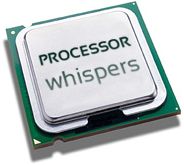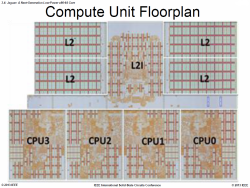Processor Whispers: About Giants and Slingshots

by Andreas Stiller and Martin Fischer
From the processor perspective, the International Solid-State Circuits Conference (ISSCC) in San Francisco was mostly notable for its rehashes from the Hotchips Conference in August 2012, but also for some news here and there.
The processor session was kicked off by IBM, with a meagre portion of details about the zNext mainframe processor, zEC12. Likewise, Oracle mostly rehashed information about the 16-core UltraSparc T5 and Fujitsu presented some new details about the 16-core SPARC64X "Athena". Only the Chinese, in the form of Professor Weiwu Hu, were able to present something new, namely the Godson-3B1500. The new 8-core chip, manufactured with 32nm technology, is supposed to deliver 173Gflops at 1.35GHz with a power consumption of no more than 40 watts. But for some reason, the supercomputer Dawning 6000, announced ages ago and meant to rely on the predecessor Godson 3B – which was presented two years ago, also by Professor Weiwu Hu – has yet to materialise.
Intel was conspicuous too, by its absence, and was only present in two other ISSCC sessions, which covered power management technologies and fast I/O (with 1Tbit/s per port). Well, Intel could have at least said something about the next Itanium generation Kittson, namely that it intends to heavily row back from its plans for this last Mohican. No modern 22nm process with tri-gate transistors, but only the inexpensive reuse of the well-tried 32nm process. No platform compatibility with the upcoming Xeon MP processors with PCIExpress 3.0 and DDR4, but a simple socket successor to the current Itanium systems with PCIExpress 2.0 and DDR3. So, just a little maintenance care in the Itanium hospice – and that's it.
And let us not forget AMD. Business boss Lisa Su was given the chance to hold the opening keynote, which she used to advertise the Heterogeneous System Architecture (HSA). Here, the next step is now imminent: with Kaveri, a shared address space for CPU and GPU is being introduced that will allow a fine-grained integration of shared computations. So far, both are on the same chip, but they each run individually, connected through a fast internal HyperTransport-like bus.
And AMD's Islands?

![]() A new picture of the Jaguar. Apart from the four cores it also shows the shared 2MB L2 cache, divided into four segments.
Shortly afterwards, AMD's processor designers introduced "Jaguar, A Next-Generation Low-Power x86-64 Core". The title somehow rings a bell – the designated video game console engine was presented under this title at the Hotchips Conference six months ago. Back then, it was Jaguar chief architect Jeff Rupley who gave the speech – but, like so many other AMD colleagues in Austin, he has meanwhile defected to Samsung's local R&D centre. One wonders what Samsung plans to do with this concentrated acquired x86 know-how ... Maybe the company should also have hired a few good programmers, some that are familiar with UEFI, for instance. If they had done so, it probably wouldn't be possible to permanently bring Samsung's modern notebook generation to its knees with Ubuntu crash dumps or simple Windows API requests.
A new picture of the Jaguar. Apart from the four cores it also shows the shared 2MB L2 cache, divided into four segments.
Shortly afterwards, AMD's processor designers introduced "Jaguar, A Next-Generation Low-Power x86-64 Core". The title somehow rings a bell – the designated video game console engine was presented under this title at the Hotchips Conference six months ago. Back then, it was Jaguar chief architect Jeff Rupley who gave the speech – but, like so many other AMD colleagues in Austin, he has meanwhile defected to Samsung's local R&D centre. One wonders what Samsung plans to do with this concentrated acquired x86 know-how ... Maybe the company should also have hired a few good programmers, some that are familiar with UEFI, for instance. If they had done so, it probably wouldn't be possible to permanently bring Samsung's modern notebook generation to its knees with Ubuntu crash dumps or simple Windows API requests.
There are a few AMD employees who haven't moved to Samsung yet, like AMD Fellow Teja Singh, who once came to AMD with Alchemy. At ISSCC, he announced that, according to the simulations, the Jaguar chips achieve more than 1.85GHz, that their TDP is between 5 and 25 watts, that they have a small energy-optimised loop cache (4 x 32 byte) and that, in some cases, the cores are supposed to wake up significantly faster from the C6 and CC6 sleep modes than its predecessor, Bobcat.
Two prototypes with Jaguar cores were presented by AMD at CES, namely Temash in the 5 watt region and Kabini somewhere between 15 and 25 watts. Temash is planned to be released with four cores and 1GHz of clock speed with the name A6-1450. And the web site Fudzilla has dug up the labels for Kabini: E1 2210, E1 3319 and X2 4410 for two cores and 15 watts, X4 4410 with four cores and 15 watts, and last but not least the high-end X4 5110 with the 25 watts mentioned in the presentation.
AMD's Slingshot
No, Ex-AMD CEO Hector Ruiz, who got himself talked about in the context of insider trading, has not named his book "AMD inside". The book's title is "Slingshot", AMD's fight to liberate the industry from Intel's ruthless grip. Slingshot was the code name of the project that had the goal of bringing Intel to its knees in court for anti-competitive conduct. In the end, Intel actually had to pay $1.25 billion – "far too little", Ruiz judges in his book, which is supposed to be published in April. Today though, one could almost buy up AMD with that sum.
Apparently, AMD's blood-letting is also affecting the graphics sector. Shortly before ISSCC and the simultaneous launch of the GeForce GTX Titan, NVIDIA's first gamer graphics card with the GK110 GPU, AMD hastily convened a conference call. The surprising news: there is no direct Titan competitor and there won't be one until the end of the year. Only then will the Radeon HD 7970 GHz Edition be replaced by a new generation. Instead, AMD is pitting the Radeon HD 7990, a fat dual-GPU graphics card with two Tahiti chips, against NVIDIA's transistor monster. A rather unfair duel – after all, NVIDIA also offers the GTX 690, whose two GK104 chips surpass the Titan as well.
And how about Sea Islands, the dubious new GPU generation? Well, it's more aimed at the mobile and OEM market and won't bring any big architectural changes in comparison to Southern Islands. At least AMD intends to introduce some new graphics cards in 2013, probably mostly in the mid-range segment though. After all, that's where most of the sales are generated.
And sales is something AMD needs some more of anyway; an AMD share now costs less than a doner kebab in Berlin. That's why buyers of AMD cards from the HD 7800 and HD 7900 lines can now get codes for full games, and actually good ones at that. So, at least in the graphics sector, AMD is focusing on its target group: gamers. NVIDIA, in contrast, apparently has no need to give away grand extras. The company's reaction to AMD's Never Settle Reloaded bundle: a few shabby bonuses for free-to-play games.
AMD's big trump card could be the new PlayStation and Xbox consoles with AMD GPUs and GCN technology. Game developers will probably start to optimise their games particularly well for AMD hardware, which, in the end, should also benefit the PC gamers with Radeon graphics cards. Who knows, perhaps the green "The way it's meant to be played" logo will soon turn red.
(djwm)




![Kernel Log: Coming in 3.10 (Part 3) [--] Infrastructure](/imgs/43/1/0/4/2/6/7/2/comingin310_4_kicker-4977194bfb0de0d7.png)

![Kernel Log: Coming in 3.10 (Part 3) [--] Infrastructure](/imgs/43/1/0/4/2/3/2/3/comingin310_3_kicker-151cd7b9e9660f05.png)












